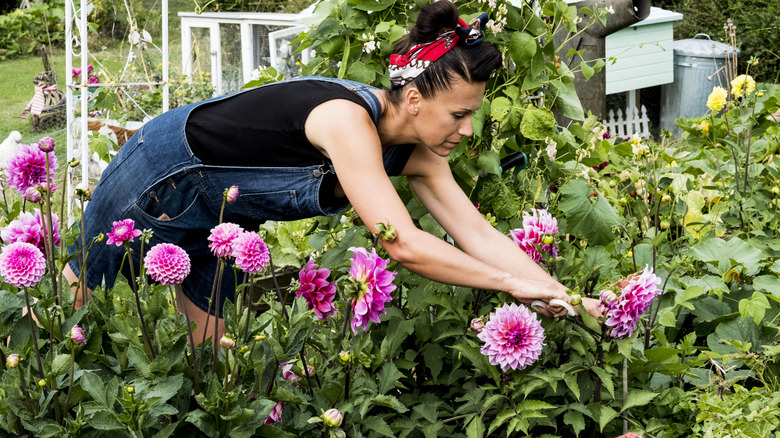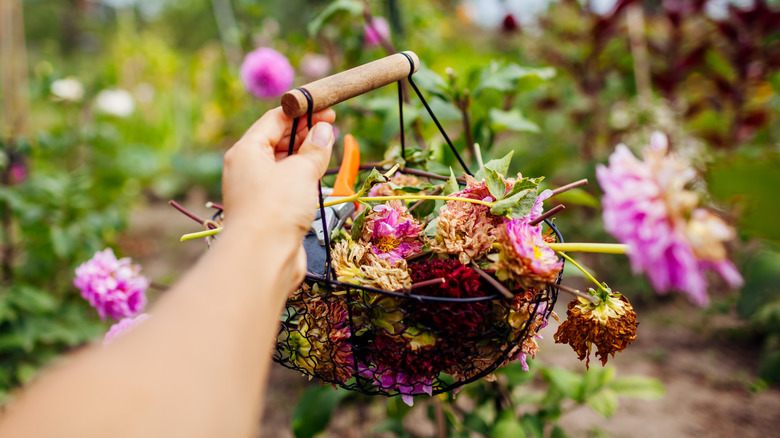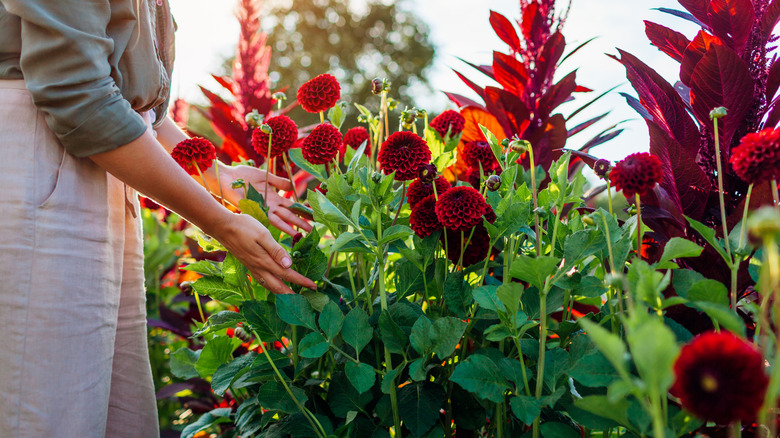Try A Two-Step Method For Gorgeous Dahlias That Will Bloom All Summer
The dahlia (Dahlia spp) is a charming flower that makes gardeners wait until the middle of summer to enjoy blooms that range in color from deep purple to salmon pink and delicate yellow. It's worth being patient, though — dahlias, which are available in many show-stopping varieties for your summer garden, can keep blooming through the middle of fall when they are properly cared for. Removing the flowers as they reach the end of their lives, a process known as "deadheading," is the key to keeping their showy blooms going all summer, and it can be accomplished in two simple steps. First, identify the buds that need to be deadheaded, then cut off the whole stems attached to those buds, keeping the set of leaves below them intact.
Plants like dahlias will naturally keep producing blooms until they can set seeds in the ground. Since deadheading stops the fading flowers from getting to the stage where they produce seeds, it convinces the plant to put its energy into making more flowers. Naturally, deadheading is not something you will want to do if you're trying to save the seeds. At the end of the season, it makes sense to stop your deadheading endeavors if you're interested in trying to grow the dahlias from seed in the next season, which can actually result in different varieties. Check for seeds from dried-up spent blooms in the fall, when the season is over and many gardeners start the process of storing the dahlia tubers.
How to deadhead dahlias
Deadheading should be done regularly to keep dahlias blooming at a pleasing pace. That being said, you don't want to confuse dying flowers with new buds. Those that are ready to be cut off have a pointed shape, while new buds are more round, As logic would suggests, it's usually best to leave the rounded buds intact, but there are some instances when you may want to cut blooms to get a certain result from your dahlias. Cutting off buds on either side of a cluster leads the plant to focus on growing larger blooms, for example.
When you're sure you've found the bloom that has faded, hold it and trace the stem down to the next point that's healthy, such as a leaf node or bud. A mistake to avoid when deadheading dahlias, though, is cutting too far down. It's important to cut at the right point so you don't wind up hurting the healthy parts of the plant and undermine your goal of having it produce more lovely flowers. Although this process is recommended for most dahlias, there is also a hybrid variety known as 'Knockout' from the Mystic Illusion series that gardeners don't need to deadhead at all, since it produces dark seed heads which blend into the garden and add to its overall charm.
Other ways to keep dahlias blooming
In addition to your deadheading routine, various factors, like your location, level of sun, and fertilizer make a difference in how long dahlias bloom. One of these factors depends on where your garden is located. Dahlias can grow as perennials in USDA Hardiness Zones 8 and higher, meaning they may have a shorter bloom period there but can re-emerge each year. They are annuals in cooler regions, meaning that they will have a longer blooming season in these places. Deadheading can still give the dahlias a chance to bloom for longer where they are perennials, but they may require some attention in other ways.
Fortunately, other factors that encourage blooms are more firmly in your control. Use a fertilizer that is low in nitrogen, and don't overdo its application, since dahlia's blooms may be smaller or non-existent if their soil has too much nitrogen. And the best place to plant dahlias for stunning blooms is a spot where it they get six to eight hours of daily sun, but will also get some shade if temperatures soar above 100 degrees Fahrenheit. A place that gets most of its sun in the morning, before the hottest part of the day, is a good choice.


